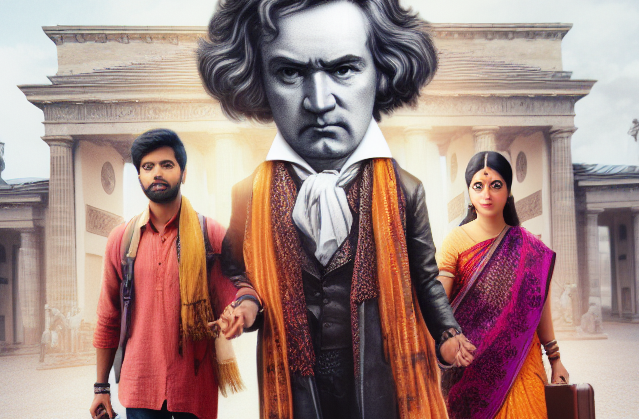Education is a serious business, no matter where you are. But how that business is run? Well, that’s a whole different story! Having lived in Germany for a while and grown up in India, I’ve had the chance to observe both school systems up close. And let me tell you—if the Indian system is like a high-speed train, Germany’s is more like a well-organized maze.
So, grab your backpacks (and maybe a cup of chai or a pretzel), because we’re about to compare these two worlds of education!
The Great School Sorting Hat
Germany 🇩🇪
Germany’s education system is known for its complexity, mainly because it allows students to take different career paths early. Unlike India, where all students follow the same curriculum until Grade 10, German students get sorted into different types of schools based on their academic performance by Grade 4 (or Grade 6 in some states).
Here’s how it works:
1. Grundschule (Primary School) – Grades 1 to 4 (or 6 in some states)
• All children start in the same school, learning basic subjects like Math, Science, German, and Social Studies.
• At the end of this phase, teachers and parents decide which secondary school best suits the child’s academic ability.
2. Secondary Schools (Grades 5 to 12/13) – The Big Split
- Gymnasium 🏆 (For future doctors, lawyers, and engineers) – The most academic track, preparing students for university. It ends with the Abitur exam, which is required for university admission.
- Realschule 📚 (For balanced academic and practical careers) – Students graduate in Grade 10 and can pursue vocational training or switch to Gymnasium later.
- Hauptschule 🔧 (For vocational careers)- Focuses on hands-on skills and leads to apprenticeships.
- Gesamtschule 🎒 (Comprehensive School) – A flexible model where students can switch between different tracks.
3. Berufsschule (Vocational Schools) – Alternative to University
- Many German students choose Ausbildung (apprenticeships) instead of university.
- They learn practical skills while working part-time in a company, getting paid during training!

India 🇮🇳
India follows a uniform system across the country until Grade 10. Students don’t get split into different academic tracks early; instead, everyone follows the same national or state board curriculum.
1. Primary Education (Grades 1 to 5)
- Students study English, Math, Science, Social Studies, and sometimes a regional language.
- Schools focus on discipline and memorization skills early on.
2. Middle School (Grades 6 to 8)
- Subjects become more complex, and exams become more frequent.
- Extracurricular activities like sports and arts are encouraged but not always prioritized.
3. Secondary Education (Grades 9 and 10)
- This is where things get serious. The Grade 10 board exams (CBSE, ICSE, or state board) are a major milestone.
- Performance in these exams determines future academic paths.
4. Higher Secondary (Grades 11 and 12) – The Big Choice
- Students pick a stream:
- Science (Physics, Chemistry, Biology/Math) – For aspiring engineers and doctors.
- Commerce (Economics, Accounting, Business Studies) – For future business leaders and accountants.
- Arts/Humanities (History, Political Science, Literature, Psychology, etc.) – For those interested in social sciences, media, or arts.
- The Grade 12 board exams are even more critical, as they determine university admissions.

Key Difference:
• Germany allows students to choose their career path early, but switching later is hard.
• India keeps everyone on the same track until Grade 10, but after that, the pressure is intense.
The Exam Drama
Germany 🇩🇪
Exams? Sure, they have them. But grades are not the be-all and end-all. The German system emphasizes continuous assessment, class participation, and practical knowledge. If you fail a class, you might have to repeat the year (no shame in that—many do!). But there’s no nationwide one-exam-to-rule-them-all situation.
The big final boss? Abitur, which students in the Gymnasium take to qualify for university. But if you didn’t do well in school, no worries! Germany gives you second (and third, and fourth) chances through vocational training and alternative routes.
India 🇮🇳
Exams? Oh boy! In India, exams are everything. Your entire worth as a student is measured by marks. The CBSE, ICSE, and state board exams in Grades 10 and 12 can make or break your future. There’s also the legendary JEE/NEET/IIT entrance exams, which turn kids into walking, talking calculators.
Indian students develop superpowers—like the ability to memorize textbooks overnight and write 10 pages in 3 hours with questionable handwriting speed. Fail once? Society will remind you for life.
Key Difference:
• Germany values practical skills, while India’s system is exam-centric.
• German students have second chances, while Indian students feel immense pressure to succeed on the first try.
School Life & Discipline
Germany 🇩🇪
German schools are quite chill in some ways. No school uniforms (except in some private schools), and students call teachers by their last names (Herr/Frau Müller, not “Sir/Madam” like in India).
Classes start early (usually by 8 AM) but end early too—often by 1 or 2 PM. Students get plenty of free time, outdoor activities, and practical learning. Teachers don’t spoon-feed; students are expected to work independently. And surprise—homework exists, but it’s manageable! Exams are not directly from the book but require reasoning and analysis.
India 🇮🇳
School in India = Discipline 101. Uniforms are mandatory, haircuts are inspected, and standing up when the teacher enters is a must. Morning assembly is a ritual, complete with prayers, national anthems, and sometimes yoga (whether you want it or not).
A school day often runs till 3-4 PM, but wait—there’s more! Tuition classes, extra coaching, and hours of homework ensure that a child’s day never really “ends.”
Oh, and calling a teacher by name? Unthinkable! It’s always “Sir/Madam,” and questioning authority too much can get you in trouble.
Key Difference:
• Germany promotes student independence and self-learning.
• India enforces strict discipline but ensures structured learning.
Higher Education & Career Paths
Germany 🇩🇪
Unlike India, where college is the default next step, many German students take an alternative route. There’s a huge emphasis on vocational training (Ausbildung), where students learn practical skills and get jobs without attending traditional university.
For those who do go to university, tuition fees are almost zero at public universities. Yes, you read that right. If you get in, you study for free (except for small semester fees).
India 🇮🇳
College is everything. Whether you need a degree or not, you must get one because “Log kya kahenge?” (What will people say?). Public universities like IITs, AIIMS, and DU are top-tier but insanely competitive. Private colleges? Expensive.
Higher education in India is more about clearing entrance exams than about actual learning. Many students don’t know what they want to study; they just pick whatever gets them a “good job.”
Key Difference:
• Germany values practical experience over degrees.
• India sees higher education as a status symbol.
Final Thoughts: Which System is Better?
Both have their pros and cons.
• Germany gives students the freedom to explore career paths, emphasizes practical skills, and doesn’t make exams a “life or death” situation. But some argue that kids are forced to choose too early in their lives.
• India ensures strong academic rigor, keeps options open till later, and produces some of the world’s sharpest minds. But the stress levels? Through the roof.
If you ask me, a mix of both would be ideal—India’s drive with Germany’s flexibility. But until that happens, we’ll keep debating while German kids enjoy their half-day school schedule and Indian students pull all-nighters before board exams.
So, which system do you think is better? Drop your thoughts below—just don’t stress about it like an Indian board exam! 😉
For more information about living in Germany. Follow my blog here

